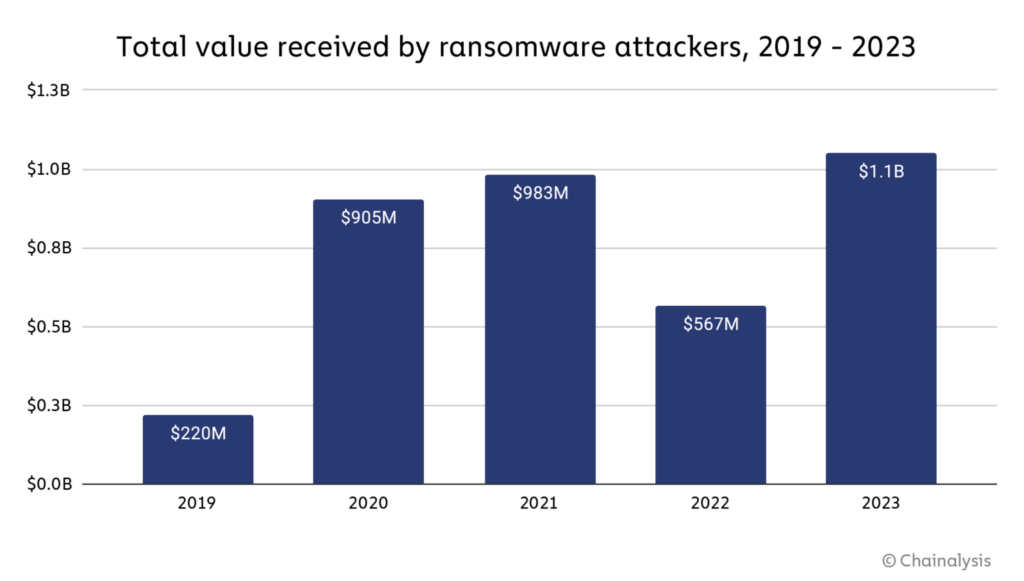
2-11 #Drama : SMIC is said to have set up a new semiconductor production line in Shanghai; TSMC is said to take monthly production from 60K to 100K monthly wafers; Wingtech has reportedly received a major smartphone order from Samsung; etc.

Google is allegedly testing the Tensor G4 chip paired with a whopping 16GB of RAM in the Pixel Fold 2. Earlier prototypes of the foldable featured Google’s Tensor G3 chipset, codenamed “zuma”, but recent prototypes have shifted to the rumored Tensor G4 chipset, codenamed “zumapro”. The increase in RAM would make sense as Google is reportedly planning to introduce more on-device AI features as part of its new AI assistant named Pixie. (Android Authority, Android Headlines)
Soaring appetite for Huawei’s artificial intelligence (AI) chips coupled with manufacturing constraints has forced the company to prioritise AI and slow production for its premium Mate 60 phones. Huawei uses one facility producing both its Ascend AI chips and the Kirin chips.The output has been hamstrung by a low yield rate, which is a proxy for production quality. Huawei has decided to scale back the production of Kirin chips for the Mate 60 series, prioritizing AI chips. It will allocate the bulk of its resources to produce the Ascend 910B and other AI chips. (Android Headlines, Reuters)
Taiwan Semiconductor Manufacturing Company (TSMC) is expanding its output in Japan with plans to build a second chip fabrication plant that marks a major victory for Prime Minister Fumio Kishida, as his government seeks to boost domestic production of integrated circuits. TSMC has said that Toyota Motor will be joining as a new investor of Japan Advanced Semiconductor Manufacturing (JASM), the Taiwanese firm’s majority-owned manufacturing subsidiary in Kumamoto Prefecture on the southwestern island of Kyushu. The TSMC board on Tuesday approved an injection of no more than USD5.26B in JASM, though it was not immediately clear how those funds would be used. (Gizmo China, SCMP)
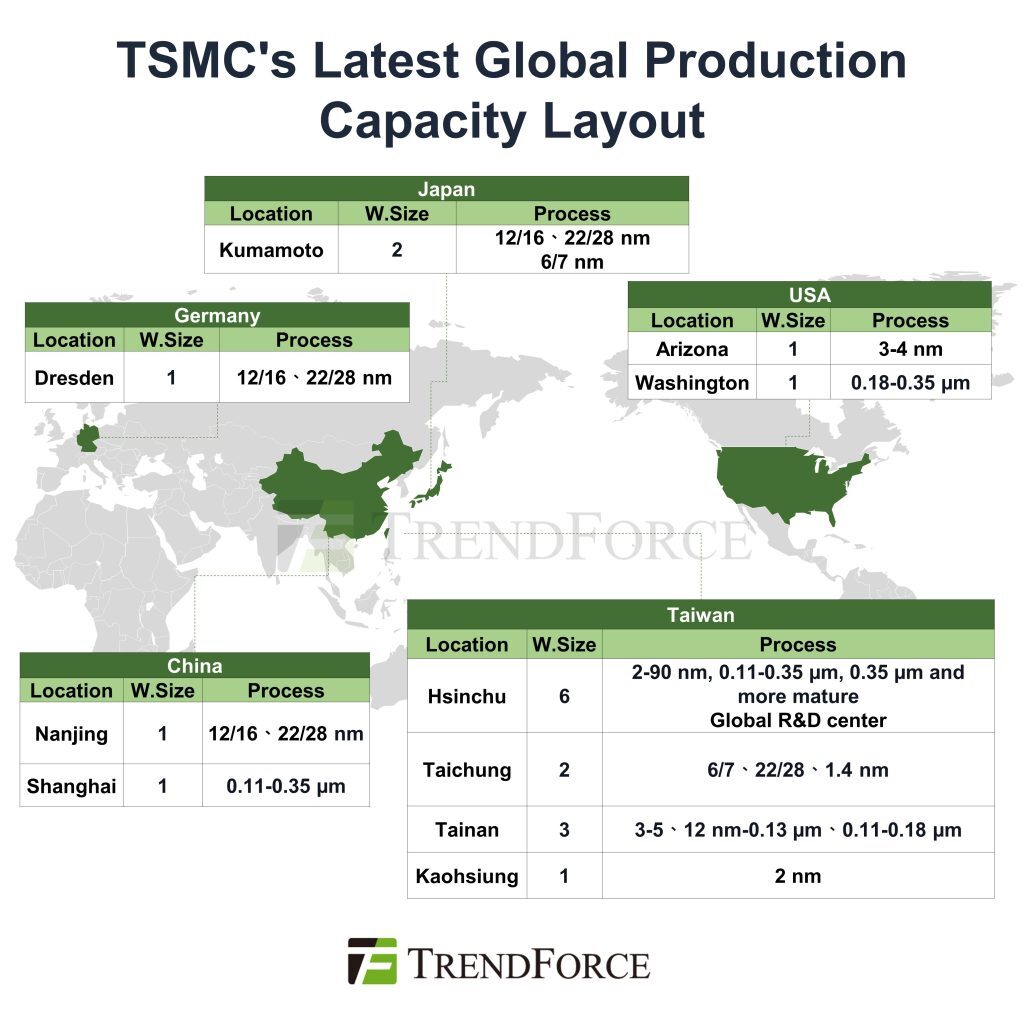
Production sites with a monthly capacity of 100,000 wafers or more are called GIGAFAB Facilities at TSMC. Currently, TSMC has four GigaFab facilities in Taiwan. With the capacity committed to the second fab of JASM announced, the production site in Kumamoto, Japan, will also reach the GigaFab level. JASM, located in Japan’s Kumamoto Prefecture, remains TSMC’s majority-owned manufacturing subsidiary. With the new investment, TSMC, SSS, Denso, and Toyota will own approximately 86.5%, 6.0%, 5.5%, and 2.0% of JASM, respectively. The first and second fabs in Kumamoto will combine to include 40nm, 22 / 28nm, 12 / 16nm, and 6 / 7nm process technologies, with wafer applications covering automotive, industrial, consumer, and high-performance computing (HPC). Fab2 is expected to start construction by the end of 2024 and is targeted to be in production by the end of 2027. JASM’s total investment in the two fabs will reach USD20B, with a combined capacity of 100,000 12” wafers per month.(Digitimes, TSMC, TrendForce)
AMD president Victor Peng stated that AI PCs will receive more widespread adoption in 2H24. The market for AI PCs “is going to continue to expand”. Looking ahead to 2024 and beyond, Peng also pointed out that AI will continue to play a significant role. Despite the substantial opportunities, the AI industry is still in its early development stages. Moreover, AI not only involves data center GPUs but also involves servers. AMD’s server market share is expected to increase further through its MI300 series accelerators. Currently, AMD is advancing its “second-generation AI PC powered by AMD Ryzen AI”. The company has showcased the next generation of the Ryzen AI technology, the Ryzen 8000 G series CPUs. (Digitimes, CNBC, Yahoo)

Singtel is working with Nvidia to make AI adoption more accessible to enterprise customers by hosting the chipmaker’s GPU clusters at its Nxera data centers that are now being constructed in Singapore, Indonesia and Thailand. Nxera, the telco operator’s newly launched data center brand, is an aggressive push to capture the growing AI workloads in Southeast Asia. It also represents the next generation of AI-ready, hyperconnected and “green” data centers. The Nvidia GPU clusters will run in existing upgraded data centers initially and can be further expanded into the new AI data centers when they are ready for service. (Digitimes, Singtel, Nvidia, Asia Nikkei, Light Reading)
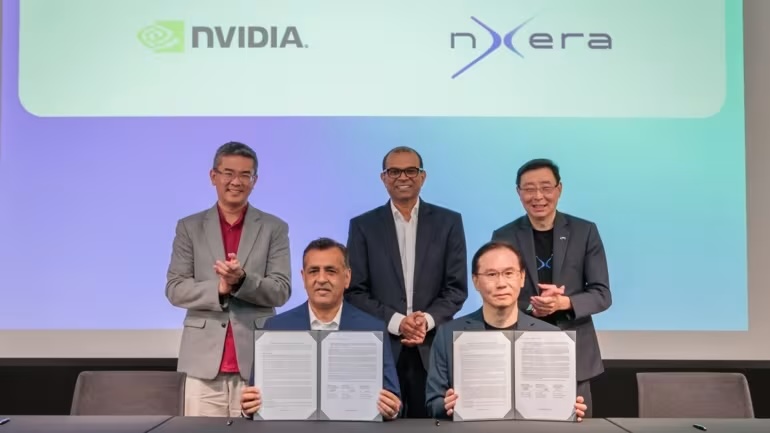
SMIC is said to have set up a new semiconductor production line in Shanghai and hopes to utilize its existing US and Dutch manufacturing facilities to mass-produce Huawei HiSilicon’s new-generation high-end mobile processors using 5nm process technology within 2024. if this smartphone chip manufacturing effort is successful, then HiSilicon’s most powerful AI processor, i.e. Ascend 920, may also be produced by the SMIC 5nm process in the future. SMIC continues to increase its 7nm process capacity to increase the yield of the Kirin series of chips and AI chips. However, the foundry service fees of SMIC’s 5nm and 7nm process are 40-50% higher than that of TSMC, while the yield is less than one-third of the similar nodes of TSMC. Hence, SMIC is pricing its 5nm and 7nm products at a 40-50% premium over what TSMC charges for similar technology nodes. (Digitimes, Asia Times, Extreme Tech, Tom’s Hardware, Financial Times)
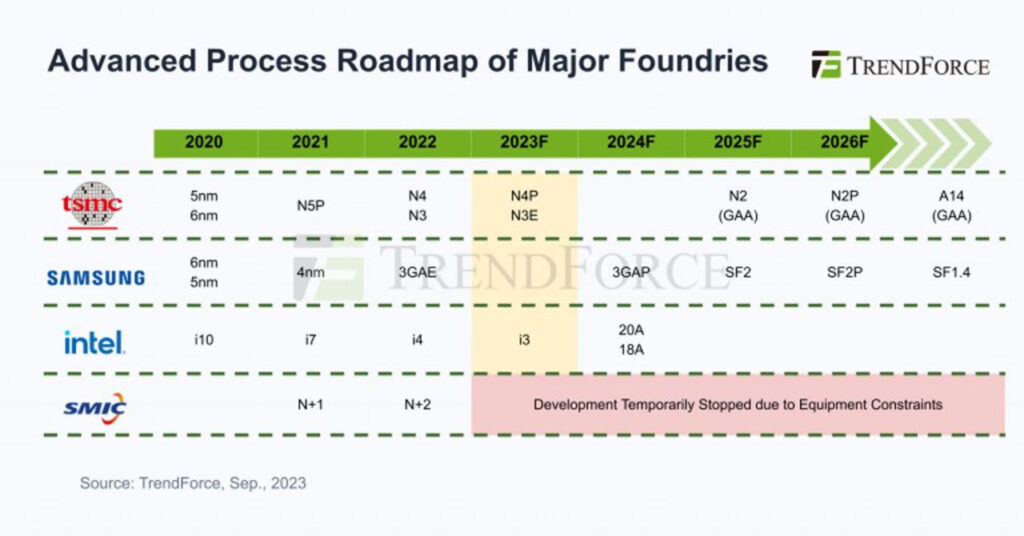
MediaTek and Qualcomm have reported stellar shipment volumes as they rode the Android smartphone AI wave in 4Q23 and shared roughly the same outlook for generative AI on smartphones, forecasting strong potential as generative AI applications take off in 2024. In particular, with flagship phones expected to see the strongest sales numbers, most of the competition between the two chip titans will be centered on this battleground. Regarding prospects for 2024, Qualcomm predicts smartphone sales to remain steady or see a slight increase, while MediaTek expects a slight growth. Both companies see a gradual increase in 5G smartphone penetration rates and expect generative AI apps to drive an upgrade cycle in the flagship segment.(Digitimes)
TSMC has allegedly not placed orders for high-numerical aperture (High-NA) extreme ultraviolet (EUV) tools and is unlikely to use the technology in 2nm and 1.4nm (A14) process manufacturing. TSMC is in no haste to deploy High-NA EUV tools, prompting the incoming and retiring ASML CEOs to visit the world’s largest pure-play foundry earlier 2024. TSMC may introduce high-NA EUV when it migrates to A10 (1nm), the sources said. The tentative manufacturing schedule for TSMC’s A10 process is set for 2029. A High-NA EUV machine will cost between EUR350M (USD11.2M) and EUR400M, a substantial rise over current EUV tools, which cost around EUR150 M per. TSMC does not want to rush in and place down orders and must thoroughly consider customers’ ideas, costs, and benefits before implementing it. (Digitimes, Digitimes, UDN)
TSMC is said to take monthly production from 60K to 100K monthly wafers, though it is also mentioned that yields will reach 80%. The 3nm chip orders that went into mass production during 2H23 already accounted for 6% of total 2023 sales. That figure is expected to climb up to 14-16% in 2024. In 2023, TSMC only had one 3nm customer, which was Apple. Now In total, TSMC is said to receive a boatload of orders from Apple, Qualcomm, MediaTek, Nvidia, Intel, and Qualcomm. TSMC will likely ramp up production of its second-generation 3nm wafers, also known as “N3E”. N3B process in 2023 was reported to have yield issues and was said to be inappropriately priced. (CN Beta, IT Home, WCCFTech, Naver)
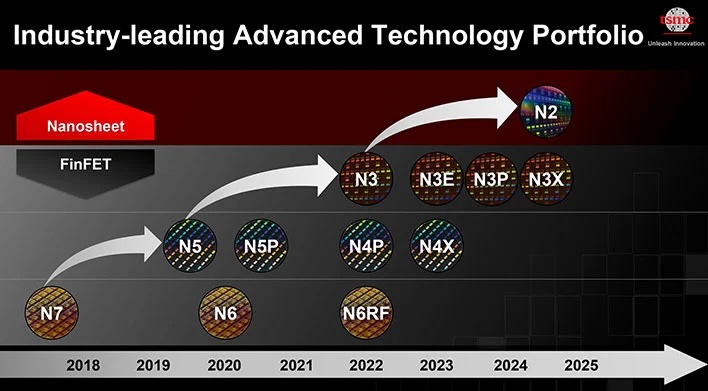
Faraday Technology has announced a collaboration with Arm and Intel to lead the development of a 64-core system-on-chip (SoC) based on Intel 18A technology. This SoC seamlessly combines Arm Neoverse compute subsystems (CSS), providing unparalleled performance and power efficiency for designing scalable hyperscale data centers, infrastructure edge, and advanced 5G networks. The Arm-based SoC is intended to be a key component of Faraday’s future SoC evaluation platform, which seeks to help customers accelerate the development of data center servers, HPC-related ASICs, and custom SoCs. The solution is expected to be available in 1H25. (CN Beta, Faraday Tech, Digitimes)
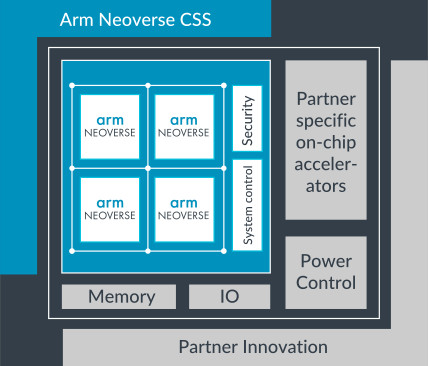

Lenovo allegedly plans to show off one of its ThinkBook notebooks with a transparent display. The laptop also seems to have some kind of transparent cover for its keyboard as well. When the transparent display is played on top of this keyboard, the renders suggest that you will be able to see the backlit keys on the keyboard. (Neowin, Windows Report)

Apple is allegedly still in the early stages of developing foldable smartphone prototypes. These prototypes reportedly include two designs resembling the Samsung Galaxy Z Flip models. Apple is working on foldable iPhones that are only half as thick as current models, so that it does not look too thick when it is closed. The company is also exploring the idea of adding an outward screen. However, challenges with components like batteries and displays have seemingly made it hard for engineers to meet these goals. Despite these challenges, Apple is said to have discussed ordering components with Asian manufacturers for two foldable iPhone sizes. However, there is a possibility the project might be scrapped if it doesn’t meet Apple’s standards. (Gizmo China, The Information, 9to5Mac)


2024 kicked off with a flurry of tech giants unveiling their AI laptops, each vying for a share of this burgeoning market. In step with this trend, memory manufacturers are gearing up to launch the next generation of Low-Power Compression Attached Memory Modules (LPCAMM) tailored for these cutting-edge devices. Samsung Electronics leads the charge, with other industry heavyweights like SK Hynix and Micron following suit, unveiling their own LPCAMM samples. This heralds the beginning of a fierce technological showdown for supremacy in innovation and market presence. LPCAMM is hailed as a memory innovation, surpassing current laptop performance and power consumption levels typically seen in DDR-based Small Outline Dual In-Line Memory Module (SO-DIMM) configurations. Industry insiders anticipate that LPCAMM could be the first product in over two decades to replace SO-DIMM, becoming a game-changer in the laptop market. (Digitimes, Chosun, Samsung)
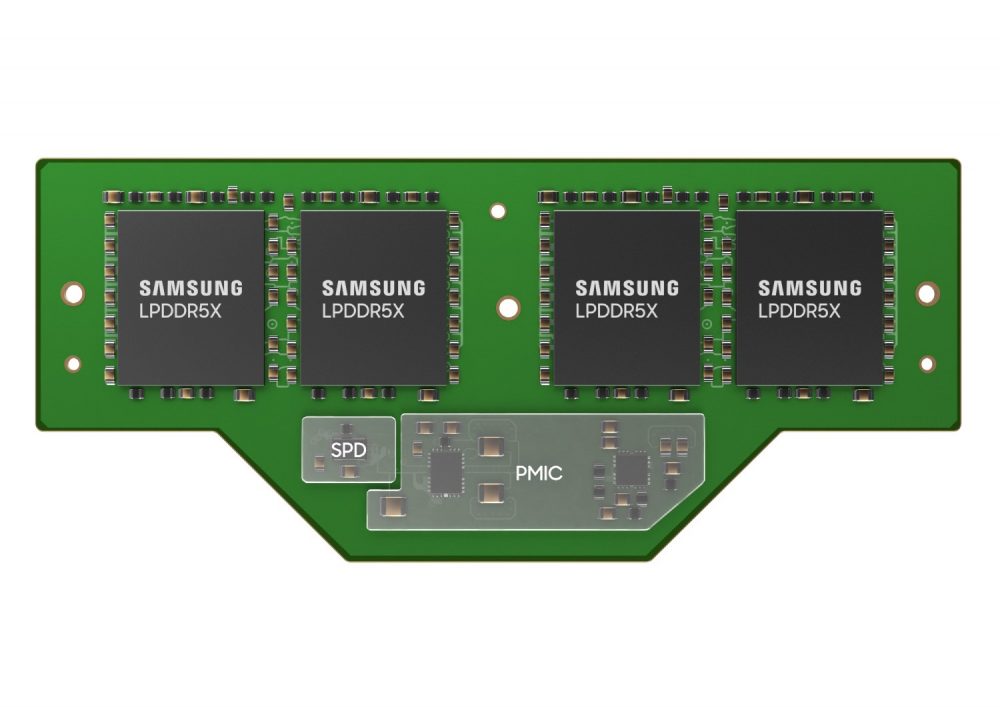
SK Hynix‘s memory business is undergoing a rapid recovery; however, facing overall semiconductor industry uncertainty, it is reportedly delaying the construction schedule of the M15X factory in Cheongju. SK Hynix had initially planned to restart construction of the M15X factory in Feb 2024 and had completed preparations, pending only approval from the CEO. However, SK Hynix ultimately decided to revisit the matter 3 months later. Previously, in Oct 2022, SK Hynix announced a plan to invest KRW15T (approximately USD11.3B) to build the M15X new factory in the Cheongju Techno Park, covering an area of 60,000 square meters, roughly equivalent to the combined size of the M11 and M12 production lines, with completion expected by early 2025. Initially, the industry anticipated the M15X factory to produce NAND Flash, but there were rumors of investment delays due to deteriorating NAND market conditions.(Digitimes, Sohu)
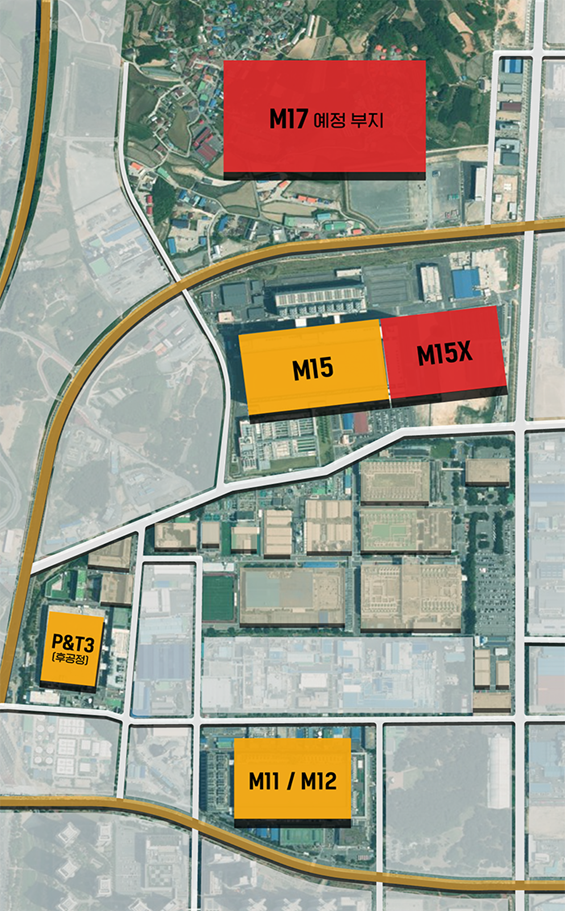

India will introduce Direct-to-Mobile (D2M) technology in 2025 to help expand TV signal reach across major cities. India may launch pilot projects on D2M in 19 cities as early as 2025. Still, it remains to be seen whether the Indian government will mandate D2M support on handsets or implement the measure voluntarily. Apurva Chandra, the Information and Broadcasting Secretary, saying that redirecting 25-30% of video traffic to D2M would alleviate congestion in 5G networks, expediting the nation’s digital progress and democratizing content delivery. Furthermore, Chandra highlighted the potential of D2M technology in reaching approximately 80-90M households without TVs across India, as only 190M of 280M households possess TV sets at home. (Digitimes, Times of India, NDTV)

Beijing-based Orienspace, which has conducted its first launch of a single-use rocket, is developing the reusable Gravity-2 and expects the rocket’s maiden flight to take place in late 2025 or early 2026, according to the co-founder and co-Chief Executive Officer Yao Song. Other Chinese companies competing to achieve reusability include Beijing Interstellar Glory Space Technology, a startup known as i-Space, which staged a test in Dec 2023. Meanwhile, a subsidiary of state-owned China Aerospace Science and Industry Corp. has conducted a vertical takeoff and landing test of its reusable Kuaizhou rocket. (Digitimes, Japan Times)
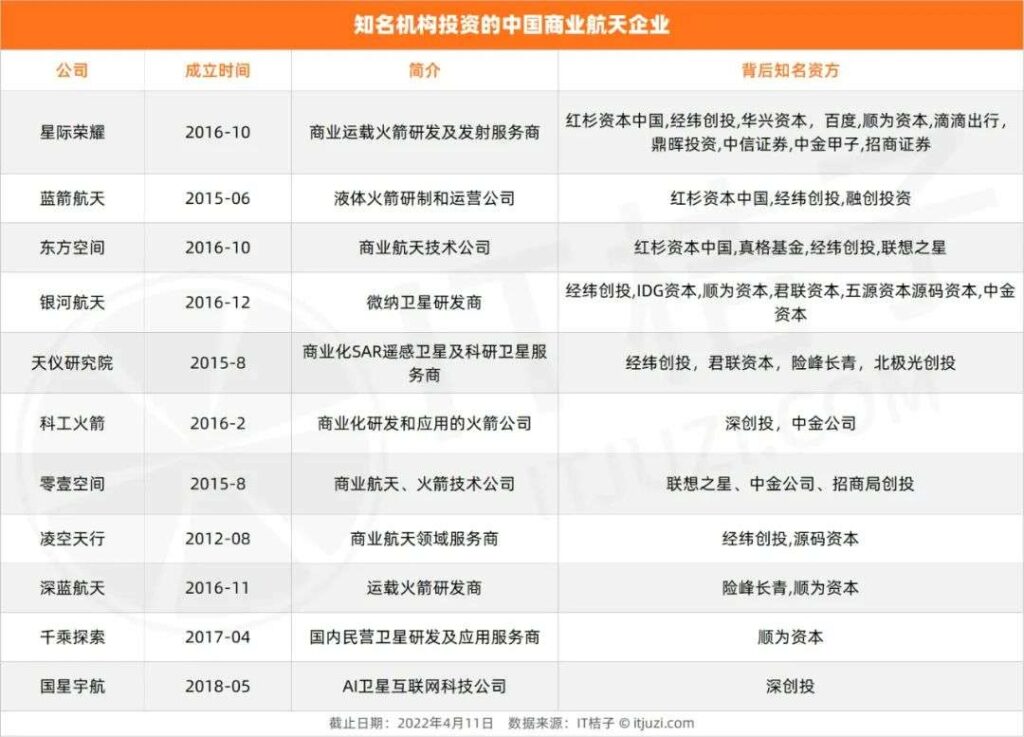

Samsung UK have allegedly confirmed that at least 4 Galaxy AI features coming to devices like the Galaxy S23 series. These include Circle to Search, Live Translate, Note Assist, and Photo Assist. Circle to Search allows users to circle, scribble, or select anything on screen and start a Google Search for it. Live Translate offers real-time translations for phone calls. Note Assist helps create AI summaries and provides automatic formatting. Photo Assist brings Generative Editing features to the Gallery app. Samsung has previously announced that the Galaxy S24’s AI features will be heading to the Galaxy S23 series, Galaxy S23 FE, Galaxy Z Fold 5 and Flip 5, and Galaxy Tab S9 series within 1H24. They are expected to land alongside the One UI 6.1 update. (Android Authority, Twitter)
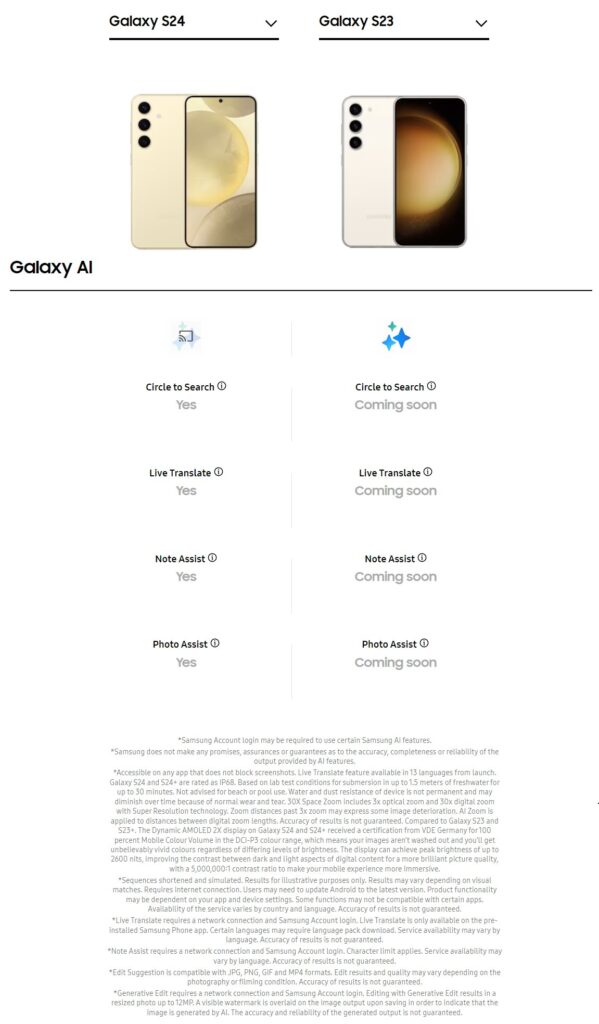
Wingtech has reportedly received a major smartphone order from Samsung Electronics. It could potentially surpass Huaqin and retake its spot as Samsung’s largest ODM. Wingtech is set to receive a mid-to-low-end smartphone order of over 40M units from Samsung in 2024. As ODMs can handle product technical R&D, design, and production, they significantly reduce manufacturing costs. Since 2019, Samsung has shifted away from 100% self-production and opted for extensive ODM collaborations. Wingtech, Huaqin, and Longcheer are the world’s top three ODM providers, with a combined market share of nearly 80%. Wingtech was the global ODM leader in 2019 but lost its position to Huaqin in 2020 after Huaqin secured a contract with Samsung. With a deepened collaboration with Samsung, Wingtech aims to regain its market-leading position. (Digitimes, IT Home, Sohu, EET-China)
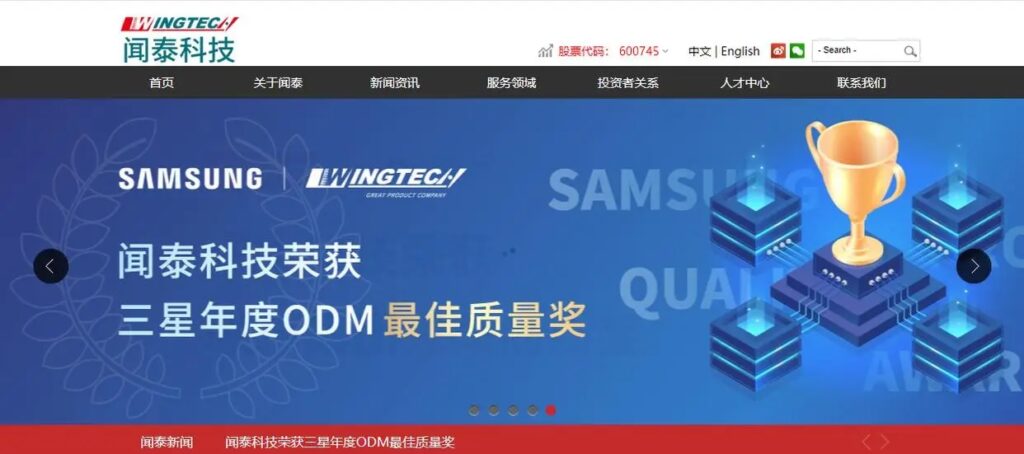
Samsung is reportedly increasing its shipment target for the Galaxy S24 series. The new devices shattered pre-order records across South Korea, India and the Netherlands which has led Samsung to up the shipment target for its S24 series to 13M units for 1H24. the previous estimate for 1Q24 was 12M units which translates to a 1M increase. (GSM Arena, Twitter)


Huawei is rumored to be developing an XR headset, which is cheaper than Apple’s Vision Pro. It uses a self-developed Kirin chip, which can achieve latency-free gesture space operation, and is equipped with a Sony 4K Micro-OLED screen. It is expected to be shipped in Jun-Aug 2024, weighing 350 grams, and the price is expected to be CNY15K. (CN Beta, Zhihu)
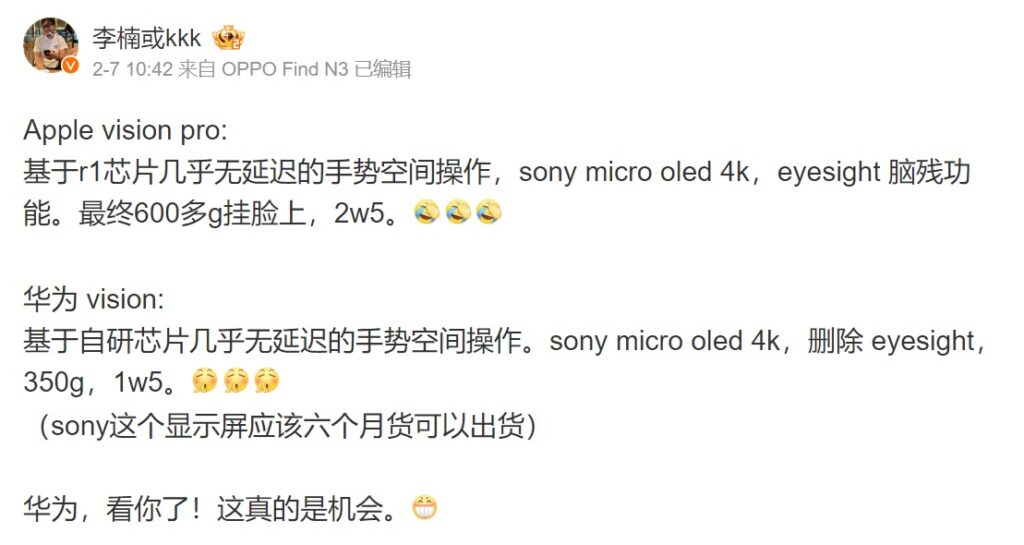

Apple has released a new open-source AI model, called “MGIE”, that can edit images based on natural language instructions. MGIE, which stands for MLLM-Guided Image Editing, leverages multimodal large language models (MLLMs) to interpret user commands and perform pixel-level manipulations. The model can handle various editing aspects, such as Photoshop-style modification, global photo optimization, and local editing. MGIE is the result of a collaboration between Apple and researchers from the University of California, Santa Barbara. (Android Authority, VentureBeat, ARVIX)
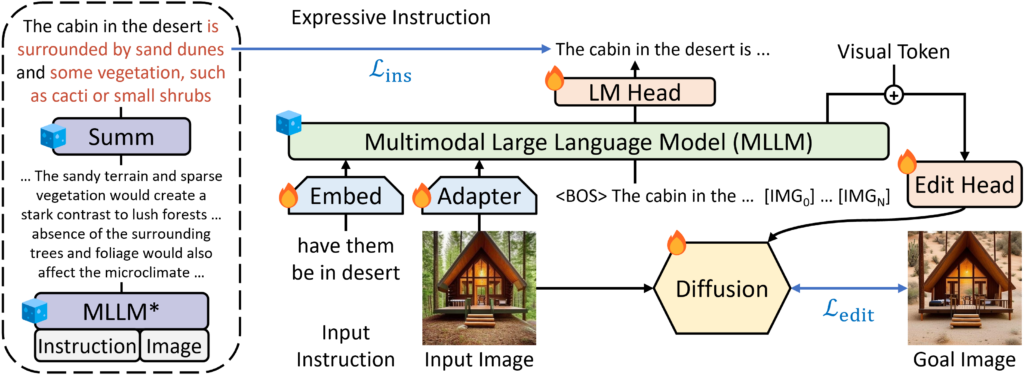
Apple’s pursuit of AI innovation has been evident in recent years. The tech giant has made a series of strategic acquisitions, including staff hires from AI startups to bolster its AI capabilities across various product lines. According to Stocklytics.com, Apple purchased up to 32 AI startups by 2023, the highest number among tech giants. In the overall AI startup acquisition, Google trails Apple with 21, Meta with 18, and Microsoft lags with 17. (Android Headlines, Statista, Apple World, Stocklytics)
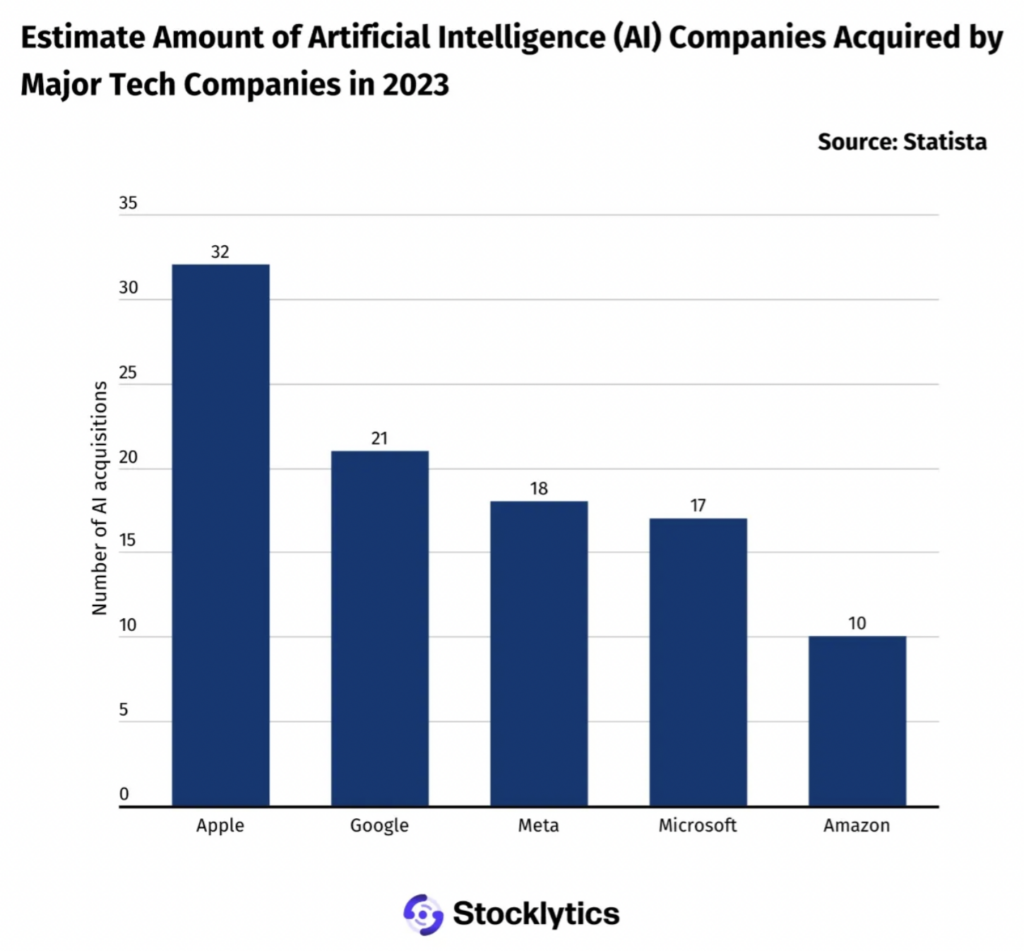

According to Chainalysis, crypto-related ransomware payments reached record-high figures in 2023. The initial estimate for crypto-related ransomware payments in 2023 is around USD1.1B. However, the real total is probably higher than that. When Chainalysis initially reported its 2022 estimates, its figure was USD457M in ransomware payments. The final total for 2022 was revised to report USD567M in crypto ransomware payments. For reference, the revised total for 2022 was about 24% higher than the initial estimate. If that trend holds for the 2023 numbers, the real amount of crypto ransomware payments could be near USD1.5B. (Android Headlines, Chainalysis)
